The history of a food-obsessed city-state through its multifaceted cuisine.
One of my earliest memories is of sitting around a makeshift communal table with my mother and sister, past our bedtime, in front of the car park at the public housing estate we lived in in Singapore. It was sometime in the mid-1980s, long after hygiene regulations had confined vendors to dedicated hawker centers. This pushcart stall, likely illegal, was probably one of the last of Singapore’s itinerant hawkers. We sat on low stools, tucking into our piping-hot fishball soup and noodles served dry.
Singaporeans are obsessed with food. We can expound ceaselessly on where to find the best bak chor mee (minced meat noodles) and will queue for hours for a good yong tau foo (surimi-stuffed tofu and vegetables). Perhaps because most of us are descendants of immigrants thrust into an artificial construct of a nation, or maybe because we live in a country that is constantly renewing and rebuilding, one of the few tangible things that connects us to the past and our cultural identity is food.
There are many facets of Singaporean cuisine: Malay, Chinese, Indian, Eurasian (a fusion of European and Asian dishes and ingredients) Peranakan (combining Chinese and Malay food traditions), and catch-all Western, which usually means old-school Hainanese-style British food—a local version of Western food adapted by chefs from the southern Chinese province of Hainan, who worked in British restaurants or households.
Feng
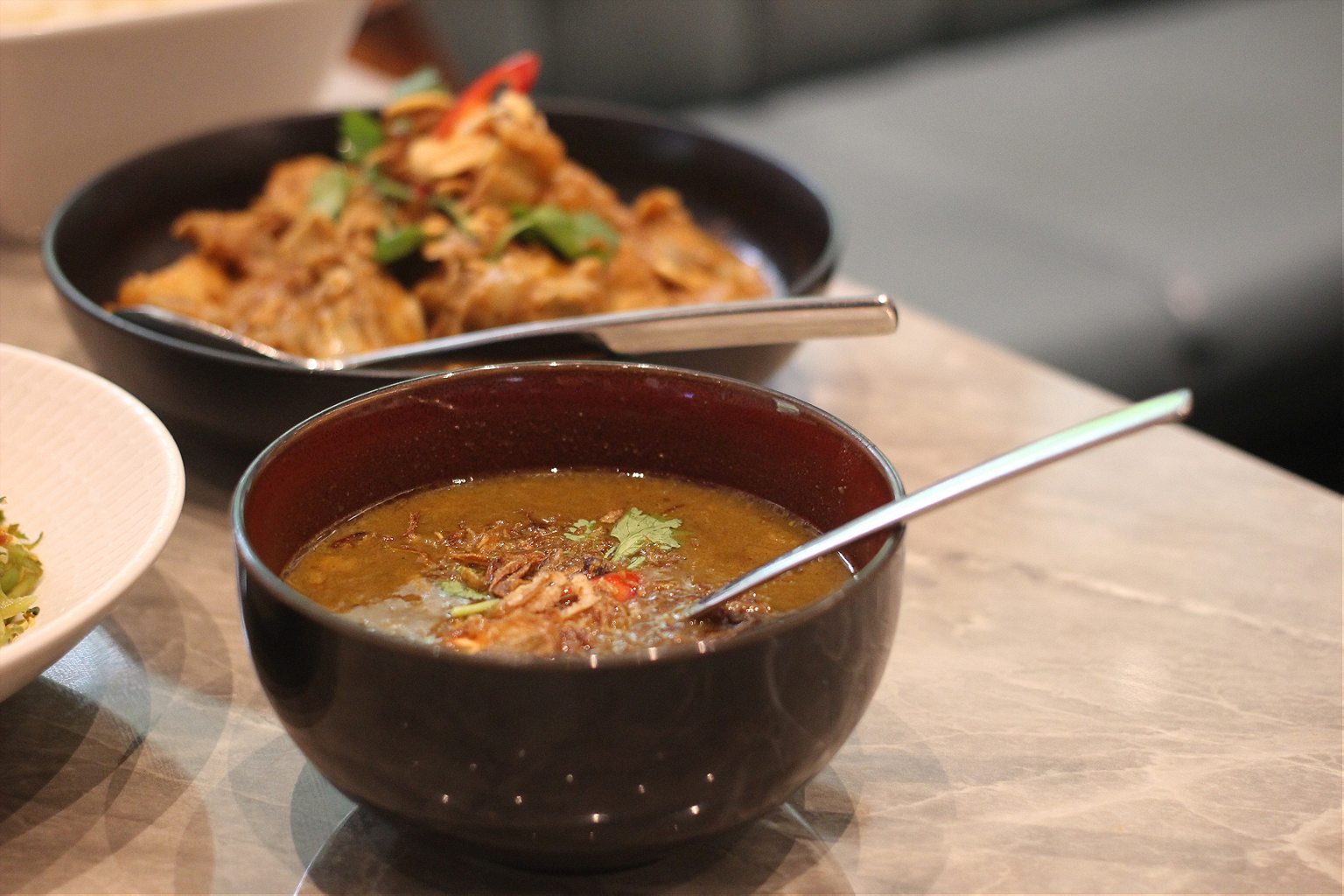
Singapore was a trading city going as early as the 14th century. Some early settlers were the Orang Laut (sea nomads) and Chinese merchants, and various Indonesian empires lay claim to the territory before it became part of the Malay Malacca Sultanate in the 15th century.
In 1511, Portugal captured Malacca, then the world’s largest spice market, in a bid to take control of the lucrative maritime Southeast Asia trade route. The Sultan of Malacca fled south and his son founded the Johor Sultanate, which encompassed Singapore. In 1613, the Portuguese came to Singapore on a punitive expedition and burned Singapore to the ground. It was abandoned until the 19th century, when Sir Stamford Raffles, representing the British East India Company, arrived.
Unlike other Europeans who later sailed into the region to try and divide up territories, the Portuguese intermarried with locals. Some of their descendants, also known as the Kristang, eventually migrated to Singapore when Malacca was seized by the Dutch in 1641.
Feng is a spicy, tangy Portuguese-Eurasian stew of diced pig offal. Damian D’Silva, executive chef at Eurasian-Peranakan restaurant Folklore, says a good feng requires “a good spice mix, fresh innards that are properly cleaned, and patience”—cleaning and preparing the offal, which includes letting it simmer for hours and sit overnight, can take days. Despite its longstanding roots in Singapore, Eurasian cuisine is notoriously hard to find at restaurants, but some chefs like D’Silva are working to change that.
Epok-epok
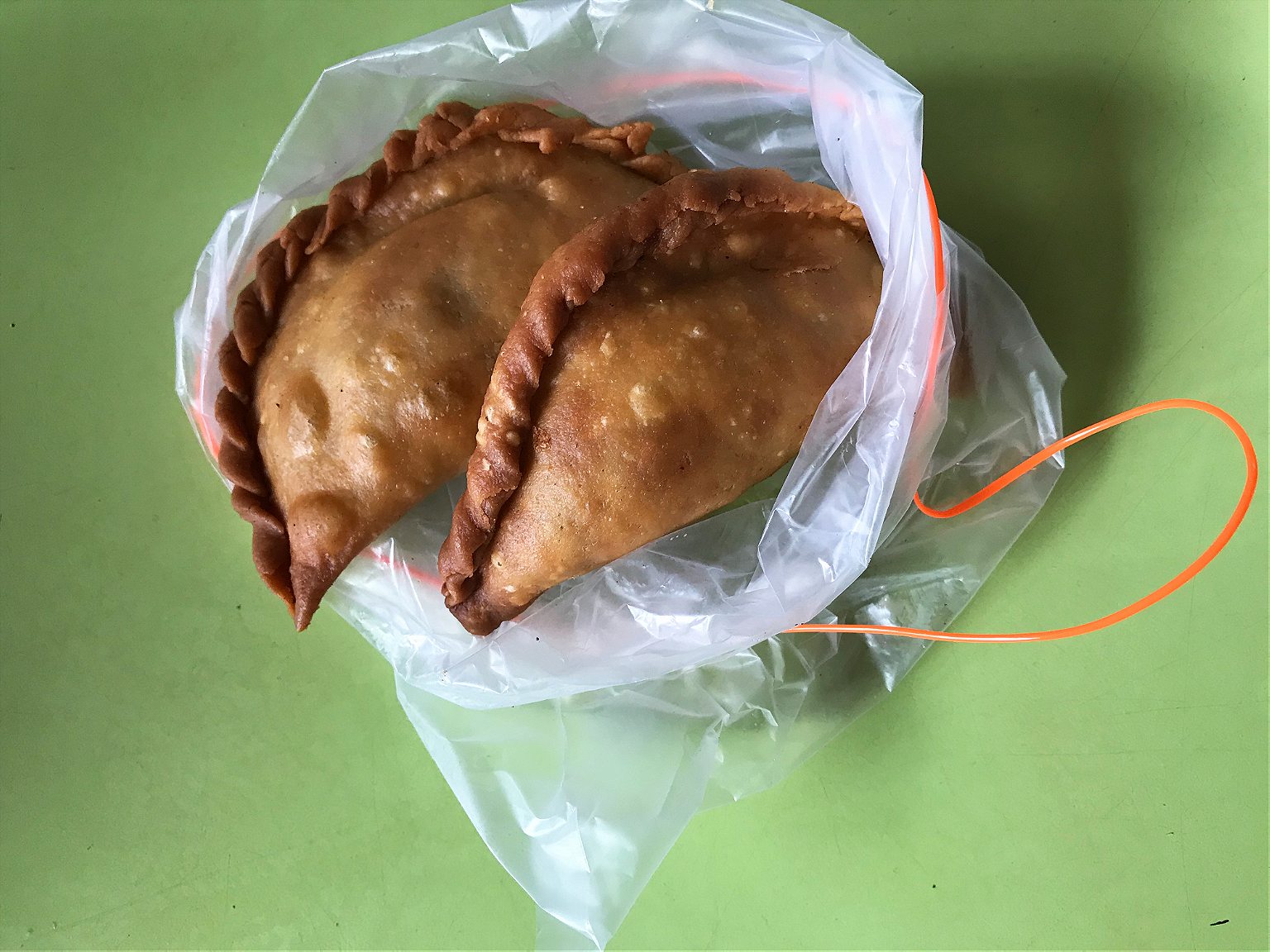
Singapore became a British trading colony in 1819. The British, whose rule lasted until 1963, left a legacy of left-hand traffic, English as the lingua franca, and the common-law system. Some say epok-epok, a popular snack, is an Indian samosa adapted to the British palate, while others say it was inspired by the Cornish pasty. (Still others say it comes from the Portuguese empada, which would imply that epok-epok predates the British.)
While some purists insist that the similar curry puff—a popular snack in Malaysia and Singapore—and epok-epok are not the same thing, Madam Halimah, who runs Yang’s Epok-epok with her sister, says epok-epok is simply the Malay version of the curry puff, with a thinner crust and finger-pinched edges. Their epok-epok, available in two flavors (sardine or curried potato), are probably among the cheapest in Singapore, priced at just S$0.50 ($0.37) each and make a perfect tea-time snack or a quick meal on the go.
Bak kut teh
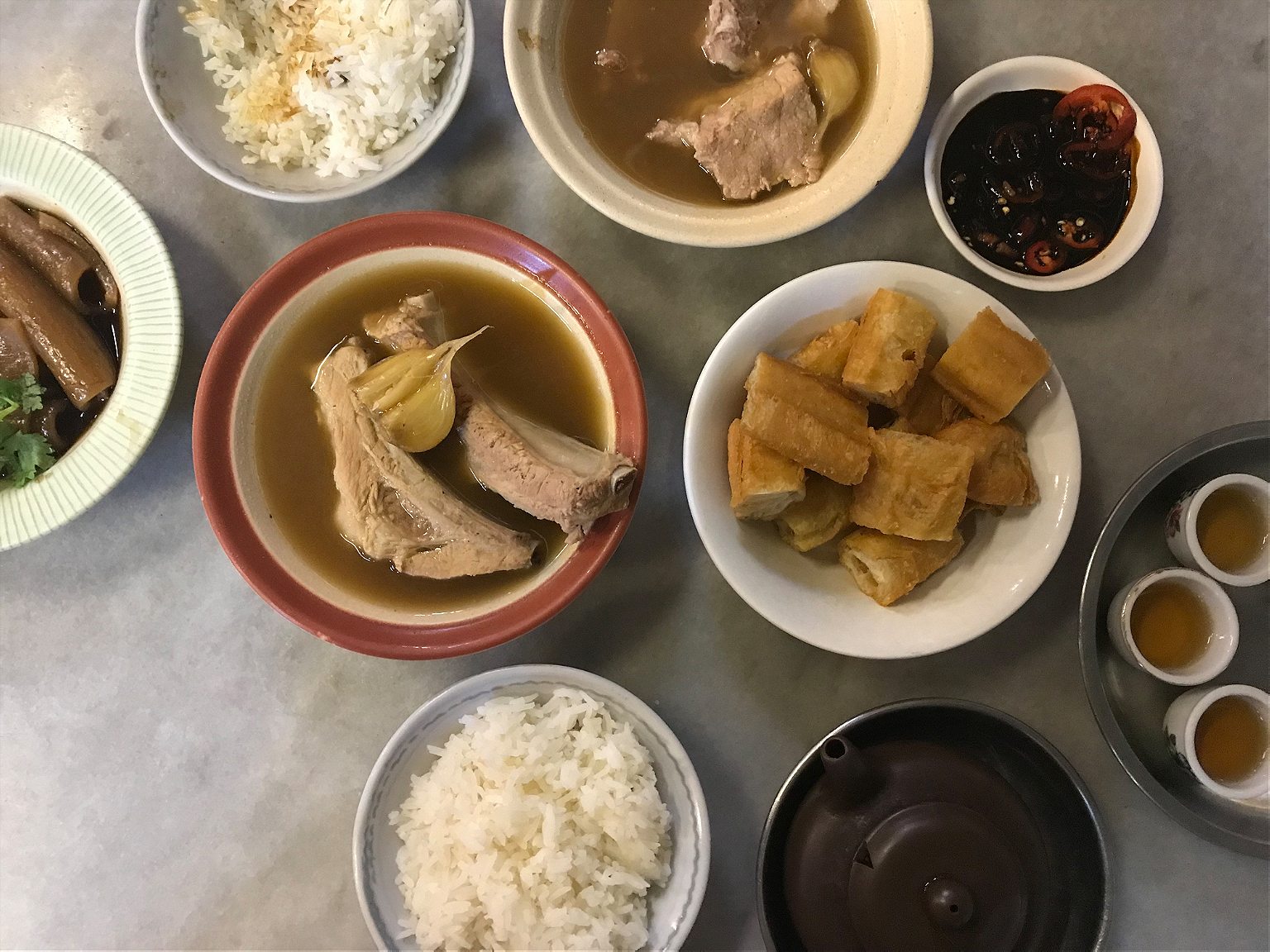
By the late 19th century, Singapore had emerged as an important regional entrepôt, given its strategic location and deep-water harbor. Laborers from southeastern China toiled along the Singapore River, unloading goods from flat-bottomed wooden boats. The origins of bak kut teh, or pork rib soup, are unclear. It may have been invented locally for these laborers as a much-needed morning energy boost, perhaps by Teochew hawkers—Chinese immigrants from the Chaoshan region in China’s Guangdong province. Others claim the recipe was brought over from China’s Fujian province.
Whether you prefer the peppery and light Teochew bak kut teh, or the more robust and herbal Hokkien variant, the soup is typically eaten with a side of steamed rice, chopped red chili in dark soy sauce and, to a lesser extent, strong oolong tea to cut through the grease. As a child, I used to pay early morning visits to the bak kut teh stall with my grandfather; we would sip hot tea together while we waited for our order.
Head to Ng Ah Sio Bak Kut Teh’s main outlet on Rangoon Road for an old-school experience, complete with oolong tea from Singapore’s oldest tea merchant, Pek Sin Choon.
Laksa

By the 20th century, with Singapore flying the free-port flag high, trade had burgeoned and attracted shiploads of immigrants. Singapore’s population jumped from about 1,000 in 1819 to over 200,000 at the turn of the century, according to a 1901 census. Chinese immigrants made up the lion’s share (72 percent) of the population, followed by Malays, Indians, Europeans, and Eurasians of mixed Asian and European descent.
Laksa, a dish of thick rice vermicelli with prawns, fishcake, tau pok (tofu puff), and see hum (blood cockles) in a rich, spicy coconut-based broth, garnished with roughly-chopped daun kesum (laksa leaves), is said to have originated from intermarriages between local Malay women and the Chinese traders and sailors who arrived in the British- and Dutch-controlled port cities along the spice route.
At Sungei Road Laksa, the broth simmers over a charcoal fire and the soup is dished out with production-line efficiency. Second-generation owner Wong Ai Tin says her father, who opened his pushcart stall in 1956, popularized eating laksa with a spoon instead of chopsticks paired with a spoon. This was perhaps out of necessity, as customers then huddled around the pushcart and ate laksa standing by the roadside.
Kaya toast
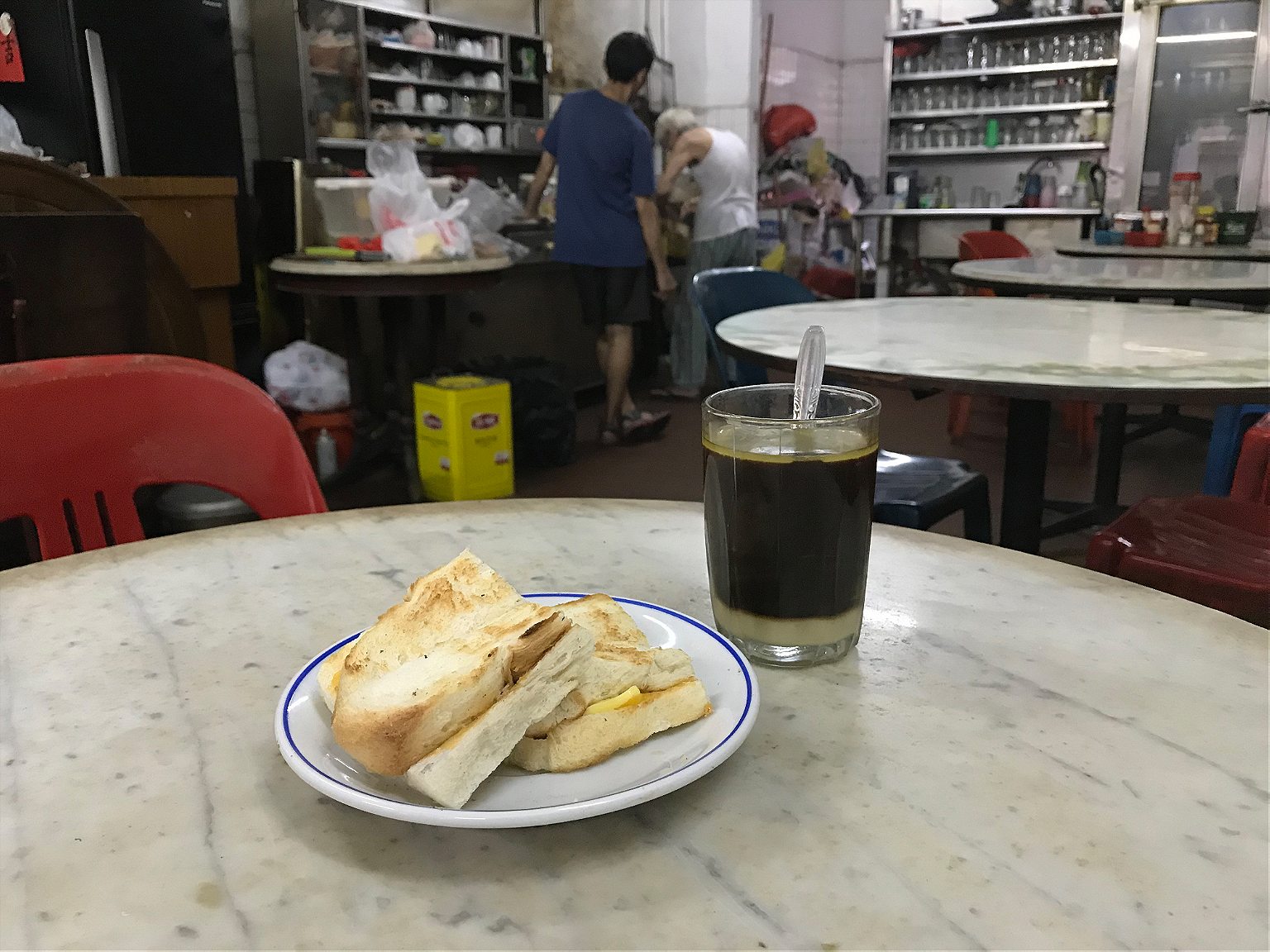
Chinese immigrants from Hainan province are said to have created kaya toast—toast served with a custardy coconut jam and butter—in the 1930s. According to legend, Hainan cooks aboard British ships were attempting to replicate fruit jam, but made do with limited ingredients, including coconut, eggs, and pandan leaves.
The economic slowdown brought on by the Great Depression offered new opportunities for these Hainanese immigrants, who took over low-rent, vacant buildings and opened kopi tiams (coffee shops).
Heap Seng Leong is a blink-and-you-miss-it relic in a nondescript public housing estate in central Singapore. Shi Pong Hsu, the 82-year-old proprietor and coffee master, has been running the show since 1974. His 55-year-old son, Shi Ting Chow, says little has changed since then: They’ve only just raised the price of kaya toast, by S$0.20 ($0.15) to S$1.20 ($0.87).
They are Hokchew, meaning their ancestors came from the Fuzhou region of Fujian province; the Hokchews were also known for opening kopi tiams. The elder Shi toasted the bread on a charcoal grill and served it alongside kopi gu you (coffee with melted butter), a Hainanese specialty from the 1930s. Some might say the kaya toast here is nothing to write home about—I’d say I didn’t come all the way here just for the toast.
Related Reads
Kueh ubi kayu
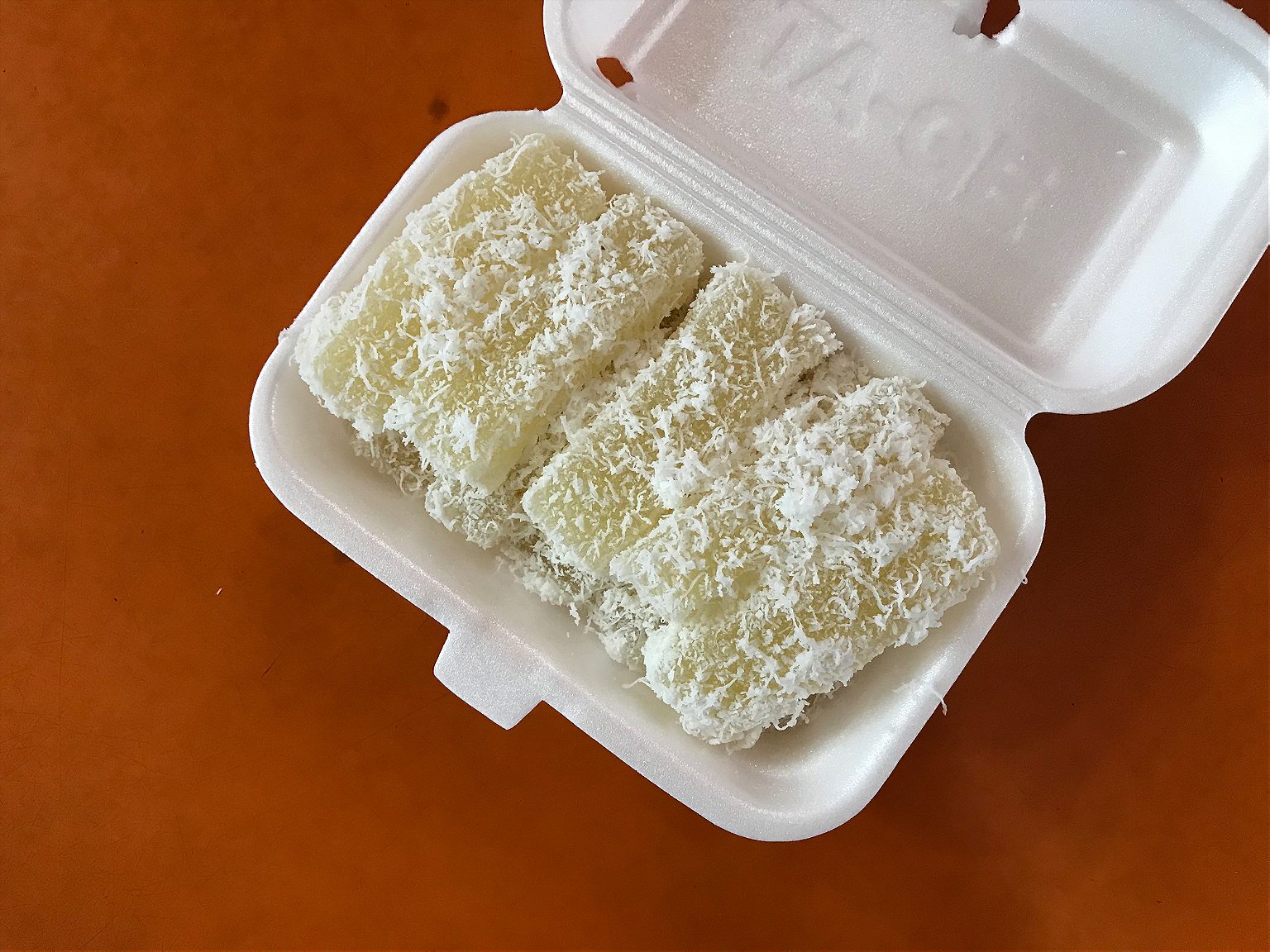
British forces in Singapore surrendered to the Japanese in February 1942, in what Sir Winston Churchill described as “the worst disaster and largest capitulation in British history.” It was renamed Syonan-to (Light of the South Island). The Japanese occupation of Singapore lasted from 1942 to 1945, and was marked by hardship and scarcity.
Kueh ubi kayu, or steamed tapioca cake, is a bite-sized dessert, consisting of steamed tapioca, a starch made from cassava root, which is then coated with grated coconut. It is widely believed to have its origins in the occupation, when many locals were forced to survive on cassava, which grows easily and can be harvested every three months.
Ang Tiong Guan has been making kueh ubi kayu for the last 30 years at Heng Heng Ondeh-ondeh and Tapioca Cake, the stall he took over from his mother after her death. It’s a laborious process: He and his wife, Ng Gek Hoe, typically spend more than 12 hours each day making the chewy kueh and manning the stall.
“We sell more tapioca cakes than my mother-in-law [did], even though the recipe is the same. Maybe during those post-war days, the stigma of eating tapioca cake was too strong,” Ng says. Their stall opens at 7 a.m. and they usually sell out by midday.
Fish-head curry

Fish-head curry was invented in Singapore in 1949, when Marian Jacob Gomez, an Indian restaurateur from Kerala, wanted to create a South Indian-style dish to cater to Chinese customers who considered fish head a delicacy.
Around this time, Singapore witnessed the first wave of Indian goldsmiths arriving from Tamil Nadu, who followed in the footsteps of earlier Indian immigrants, most of them ethnic Tamils from South India who worked as laborers, money-lenders, and traders. There were even some convicts who decided to settle down in Singapore after serving their sentences.
“Today, tourists from India come to our restaurant and some of them are shocked to see that fish-head curry is on the menu, as the dish does not exist in India,” says Nagajyothi Mahendran, the third-generation owner of Samy’s Curry. Mahendran says her grandfather, M Veerasamy, started cooking the dish in a shophouse—a mixed-use building—in the 1960s.
Samy’s Curry, now housed in a 5,000-square-feet colonial house, serves about 50 claypots of the dish each day. Opt for biryani rice and don’t forget to fold your banana leaf in half, inward towards yourself, kept in place by your cutlery, when you are done eating—basic banana-leaf etiquette.
Sambal stingray
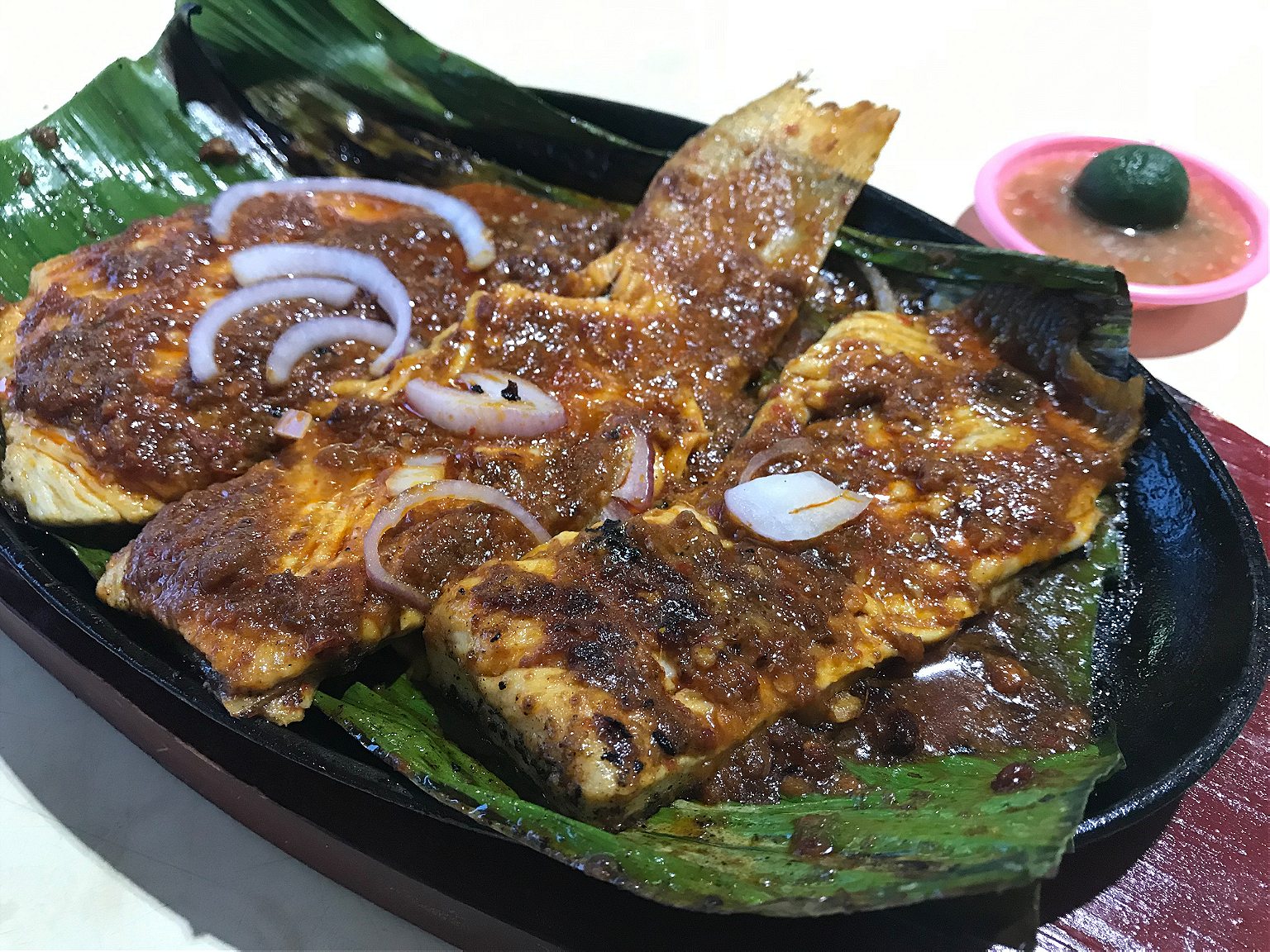
Singapore’s relationship with Malaysia is complicated, to say the least. The postwar years were a time of social unrest, unemployment, and anti-colonial sentiments in Singapore, which eventually culminated in the establishment of the Federation of Malaysia in 1963—uniting Singapore, Malaya, Sarawak, and North Borneo under one flag. The union was not to last—Singapore left a mere 23 months later.
As with many local dishes in Malaysia and Singapore, there is ongoing debate regarding the origin of sambal stingray. Depending on who you ask, it could be a Malaysian dish that gained popularity in Singapore, or a Singaporean Malay creation that is commonly sold by Chinese hawkers. What we do agree on is that this dish single-handedly changed the fate of stingray, once an unpopular fish. Despite being classified as an overfished species by the World Wildlife Fund (WWF), it is still a relatively inexpensive fish in Singapore today.
Typically slathered with spicy, aromatic sambal chili paste, wrapped in banana leaf, and grilled, this dish is a hawker center mainstay—Chomp Chomp BBQ at Fengshan Market & Food Centre does a pretty decent version, best enjoyed with a squeeze of calamansi lime before serving. Chinchalok, a spicy and pungent fermented shrimp sauce dip, is optional.
Kacang puteh
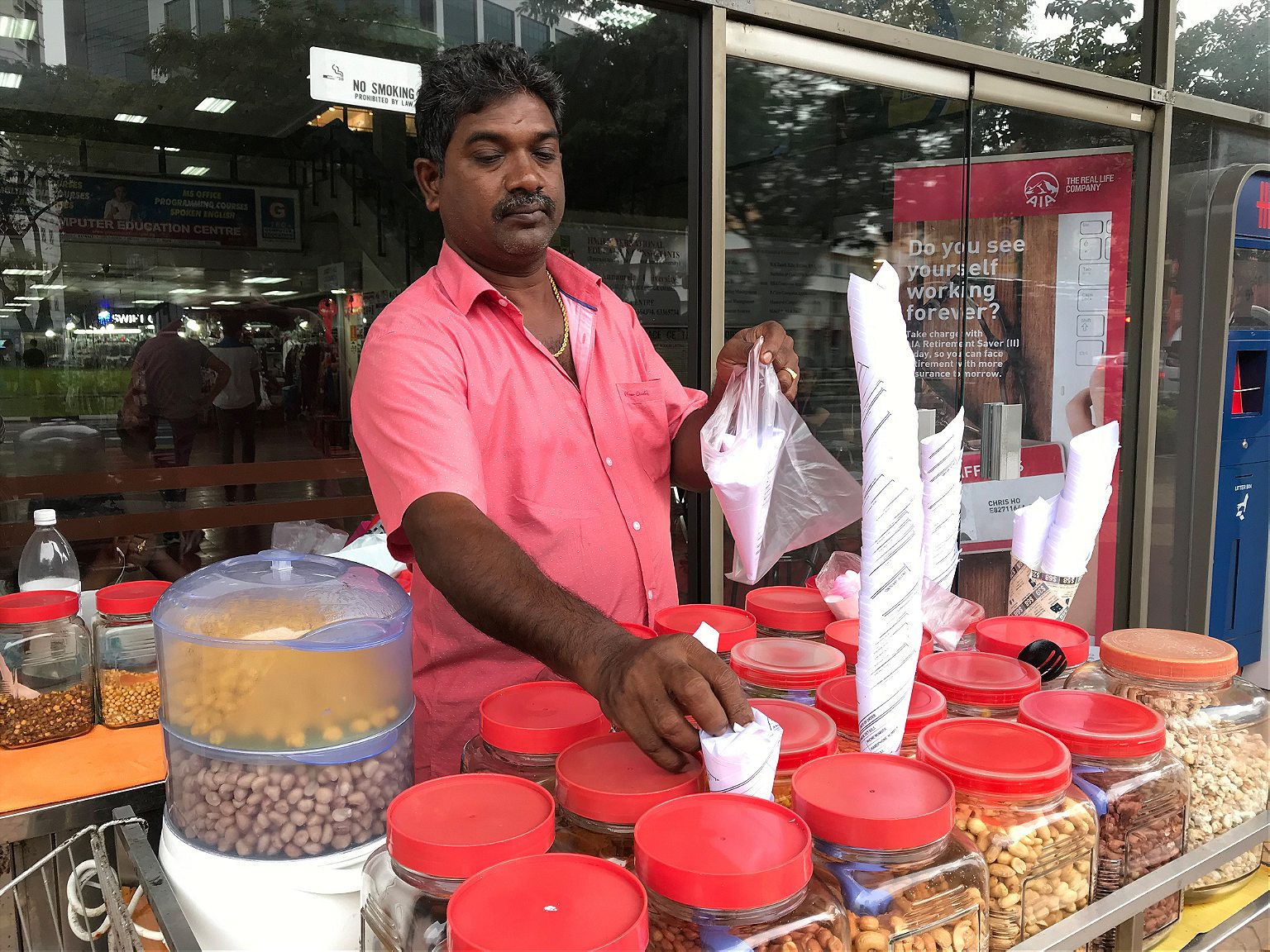
Before television sets became commonplace in Singapore, cinema was the main source of entertainment for many Singaporeans, its appeal wide-ranging with screenings of American, British, Chinese, Malay, Hindi, and Tamil films.
Kacang puteh, Malay for “white beans,” is a selection of nuts, crackers, and grain legumes. The mix was traditionally packed in cones made from newspaper and sold by pushcart vendors outside cinemas. These pushcarts usually contained a range of snacks, including roasted cashew nuts, steamed chickpeas, sugar-coated peanuts, and murukku, a crunchy and savory Indian snack.
The local cinema industry managed to survive the Japanese occupation during World War II, but it took a hit in the 1980s with the emergence of video-cassette recorders and rampant video piracy. Lower cinema attendances meant fewer customers, with the arrival of cineplexes eventually sounding the death knell for kacang puteh vendors. These modern cineplexes often come with adjoining food and beverage stands and strict rules on the consumption of snacks bought elsewhere.
Amirthaalangaram Moorthy is a third-generation kacang puteh vendor whose stall is near a bus stop on Selegie Road right outside Peace Centre—a far cry from the now-demolished Hoover Theatre in Balestier, where his father used to set up his stall. He still painstakingly makes most of the snacks from scratch, but in the face of inexpensive, shiny packs of factory-produced party snacks stocked at convenience stores and supermarkets, he has stiff competition.
Mala Xiang Guo

In the 1990s, facing an aging population and declining fertility rates, Singapore opened up to immigrants and foreign workers. Between 1990 and 2015, Singapore’s population increased by 82 percent, among which citizens grew by 29 percent, permanent residents by 371 percent, and non-residents by 424 percent, according to government statistics, with most new immigrants hailing from Malaysia, China, and India.
The influx of new immigrants has contributed to the continued evolution of the Singaporean foodscape. Mala xiang guo, a fiery, mouth-numbing stir-fry of vegetables from southwestern China, has become popular in Singapore in recent years.
Stall owners Mao Congfang and Wu Zhansheng, who migrated from China’s Henan province in 2005, opened Ri Ri Hong Mala Xiang Guo, and are widely credited with popularizing the dish in Singapore.
“We’ve tweaked the dish to be less greasy and less salty to accommodate local preferences,” Mao said, adding that in the beginning, most of their clientele were recent immigrants from China. “Today, half our customers are locally born Singaporeans.”






